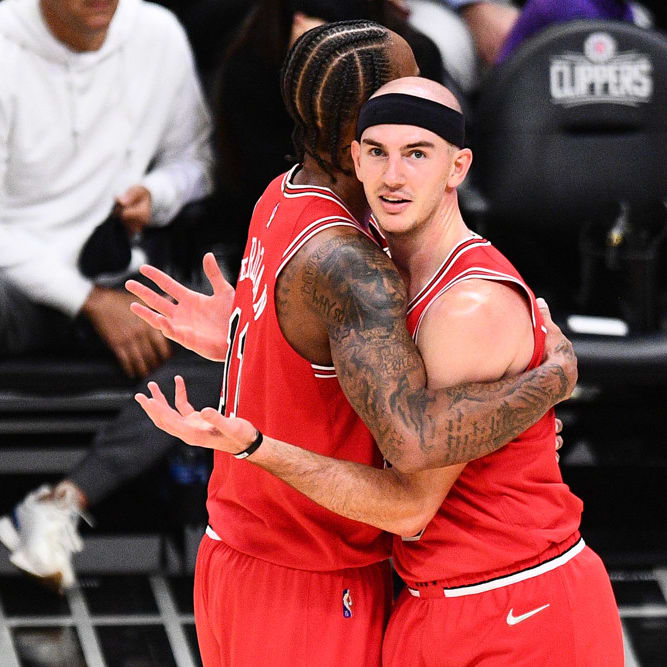This article is part of our Numbers Game series.
Fantasy analysts love to talk about pace. The reason is simple – faster play results in more possessions, and more possessions means more opportunities to pad box scores. It's all so logical. What could possibly be wrong?
Winning fantasy sports takes more than just logic. This is a game of numbers, and all the logic in world won't help us win if the underlying math doesn't support our assumptions. This week, therefore, I'm investigating pace – specifically, does an opponent's pace really matter?
Pace and Team Fantasy Points
The first topic we need to approach can be done without looking at any individual players. We need to find out whether extra possessions in a game really does translate into extra box score production, regardless of which players are accumulating the stats. Therefore, to start this investigation, I compared a team's pace to their opponents' average production.
To measure fantasy production, I used an average of DraftKings, Yahoo!, and FanDuel's fantasy scoring system. The three sites use very similar scoring rules, and where they differed, I used the average of the three (ie, Yahoo! and Fanduel both take away one fantasy point for each turnover, while DraftKings takes away half a point, so I took away .83 points per turnover). That means I count points as worth 1 point, rebounds worth 1.22, assists 1.5, steals 2, blocks 2, threes 0.33, and turnovers -0.83. DraftKings awards a bonus for double-doubles and triple-doubles, but I did not include that in my metric. I
Fantasy analysts love to talk about pace. The reason is simple – faster play results in more possessions, and more possessions means more opportunities to pad box scores. It's all so logical. What could possibly be wrong?
Winning fantasy sports takes more than just logic. This is a game of numbers, and all the logic in world won't help us win if the underlying math doesn't support our assumptions. This week, therefore, I'm investigating pace – specifically, does an opponent's pace really matter?
Pace and Team Fantasy Points
The first topic we need to approach can be done without looking at any individual players. We need to find out whether extra possessions in a game really does translate into extra box score production, regardless of which players are accumulating the stats. Therefore, to start this investigation, I compared a team's pace to their opponents' average production.
To measure fantasy production, I used an average of DraftKings, Yahoo!, and FanDuel's fantasy scoring system. The three sites use very similar scoring rules, and where they differed, I used the average of the three (ie, Yahoo! and Fanduel both take away one fantasy point for each turnover, while DraftKings takes away half a point, so I took away .83 points per turnover). That means I count points as worth 1 point, rebounds worth 1.22, assists 1.5, steals 2, blocks 2, threes 0.33, and turnovers -0.83. DraftKings awards a bonus for double-doubles and triple-doubles, but I did not include that in my metric. I will call this metric "aFPts" for "average Fantasy Points per game".
Through the first 64 games of the 2016-17 season, there is good news and bad news. The good news is, as we predicted, there is a statistical relationship between pace and opponent points per game. That means that we can say, generally speaking, there is a relationship between pace and aFPts. For every extra possession, an opposing team averages 2.4 extra aFPts. The Thunder are averaging 13.7 more possessions per game than the Jazz – according to this model, that means that Thunder's opponents should average 32.9 more aFPts than Jazz opponents. Divide that increase among the seven to nine rotation players likely to share the extra fantasy production, and that works out to a modest-but-noticeable increase of roughly 3.5-5 points extra aFPts per player.
The bad news, however, is that while a relationship clearly exists, the relationship is much weaker than you may have assumed – it is certainly weaker than I had expected. Using actual game data (instead of the model), the Thunder are one of the teams that follow this pattern the least. Oklahoma City's opponents average the-sixth fewest fantasy points per game, despite their league-leading pace. A relationship exists between pace and production, but there is enough variation that we need to move forward with caution.
Broadening Our Sample
What happens if we apply the same test to the data from an entire season? Maybe the reason 2016-17 shows only a weak correlation is because of scheduling quirks since the season only just started.
As it turns out, that worked -- at least slightly. Using all of 2015-16 as our sample data, instead of only the first 5% of the 2016-17 season, the relationship between pace and aFPts strengthened. Wide variation remained, but the pattern was more representative.
Studying The Outliers
In cases like this – a defined population, a mathematically significant relationship, but still wide variation – the next step is to look closely at the outliers, to see if there are any shared explanations. This led to more good news – all of the biggest outliers, without exception, have something in common.
The teams with extreme defenses, the very best teams and the very worst ones, were the ones least impacted by pace of play. This trend was startling for how universal it was: Seven teams differed from the pace model by more than 35%; two were the top two rated defenses; the other five ranked among the seven lowest rated defenses. A very similar pattern emerges from the 2015-16 season-long data.
Better still – for the teams with great defenses, the pace model projected too much fantasy scoring. For the teams with bad defenses, the pace model didn't predict enough fantasy scoring. This is what we would expect to find, but the fact that our expectations held true speaks to the strength of the pace model. It implies that the wide variation discussed above may not be a problem with using opponent pace to predict fantasy performance. Rather, it is a sign that pace is a starting point for a much better model – one that incorporates at least one other variable (defense) in addition to pace.
Conclusions
For teams with relatively average defenses, pace was a strong predictor of opponent production. Every extra possession translated to about 2.4 extra aFPts per team per game.
For teams whose defenses rank among the very best or the very worst, however, pace was not a great predictor of opponent production. For these teams, their defensive ability (or lack thereof) overwhelmed the predictive value of the pace.
Before fantasy managers look to opponent pace to help make roster decision, they should first check the opponent's defensive abilities.
Teams To Target
Based on this analysis, players facing the following teams may experience a production bonus, due to the opponent's fast pace and relatively average defense:
- Nuggets
- Pelicans
- Suns
Other fast-paced teams, not included in the list above due to having very good or very bad defensive metrics include the Lakers, Thunder, and Warriors. If any of these three defenses move towards league average while maintaining their fast pace, they will become teams to target.
Teams To Avoid
Based on this analysis, players facing the following teams may experience a production decrease, due to the opponent's slow pace and relatively average defense:
- Jazz
- Grizzlies
- Spurs
- Timberwolves
Not included in the list above due to having very poor defensive metrics are the Kings. If the Kings' defense moves towards league average while the team maintains its slow pace, Sacramento will become a team to avoid.
Last Note
While I have shown that very strong or very weak defenses make pace data unreliable, I have not proven that there is always a correlation between defensive ability and opponent production. The value of defensive data, and how to use it well, will be a topic of another column.
And A "Thank You"
Before you go, I want to say a heart-felt thank you to NBA.com – I often use your very thorough stats pages, and they are particularly helpful for this column. Thank you for keeping this a free, easy-to-use resource.
Do you have a topic you want Alex to investigate? Send them his way, on Twitter @Rikleen.










